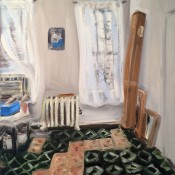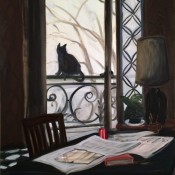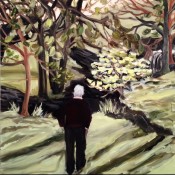KELLY MCRAVEN
Kelly McRaven was born in Dayton, Ohio in 1977. She received her undergraduate degree in painting and art history from Ohio University and her Masters degree in painting from the Tyler School of Art. She has had solo shows at the Peng Gallery in Philadelphia, the Tyler Gallery in Elkins Park, Pennsylvania and the Chinati Foundation in Marfa, Texas. McRaven’s work has also been included in several group shows at galleries in Philadelphia and New York. She currently lives and works in Brooklyn, New York.
-
Roadside tree and weed
 add to drawer
add to drawer
-
Night at Lucien
 add to drawer
add to drawer
-
Fern in yellow room
 add to drawer
add to drawer
-
Studio (with blue shoebox)
 add to drawer
add to drawer
-
Cat on balcony
 add to drawer
add to drawer
-
Meadow man iii
 add to drawer
add to drawer
Kelly McRaven describes the effect of her richly painted canvases as similar to that of a run-on sentence. The subject matter of her paintings is derived from a handful of sources found in design magazines, art history, and her own imagination. Repetition is an important aspect of McRaven’s process as she often paints and re-paints images, folding one idea into the next to create compositions that drift between truthful representation, art historical citation, and pure painterly abstraction.
Although McRaven works simultaneously within a variety of genres – decorative interiors, lush landscapes, abstractions, and mixtures of all three – the majority of her compositions depict luxuriously furnished interior spaces that immediately recall the work of painters such as Vuillard and Manet. There are rarely any human figures present in these rooms. Rather, emphasis is placed on an alluring assortment of objects, fabrics, colors, and undulating patterns. The paintings exude a romantic fascination with spaces from a different time and place, yet McRaven’s images remain somewhat elusive; they hint at nostalgia rather than suggesting something fixed indelibly in time.
While her choice of themes conjures up images of nineteenth-century bourgeois culture, McRaven’s technique directly challenges the classification of her work as a straightforward return to academic style painting. In Palm Beach Interior, for example, we see an extravagantly adorned room, complete with a plush white couch, a surplus of ornamental pillows, coffee and end tables covered in elaborate picture frames, and a large tapestry of a mythological hunting scene that obscures an entire wall. McRaven took her initial inspiration for this work from a photograph she found in an issue of Vanity Fair. The loose brushwork and the artist’s open manipulation of perspectival effect divert attention away from any sense of an accurate depiction of specific content and towards the surface of the canvas, highlighting the flowing application of paint. McRaven has since created several versions of this composition, removing elements from the original image, integrating inaccurate details and purely imagined objects, closely cropping a section of the furniture and the tapestry to the point of near abstraction in one canvas while zooming back out in another to provide a fuller vision of this opulent interior. She practices a fluid process of addition and subtraction as a means of “chewing on a particular idea” while trying to figure out how, and if, it fits into a picture.
McRaven is constantly experimenting with different poles and limits associated with the act of painting. Not only does she work within multiple genres, she also produces extremely large-scale compositions, which reach over ten feet in length, concurrently with more intimate pieces. When exhibited together, the drastic juxtaposition of scale and subject matter produces some impressive effects. Looking at Picture Room I (2004) next to Picture Room II (2005), we immediately notice that they share the same basic composition – a fireplace topped with an ornate mirror is used as a visual anchor, linking the dual depictions of this interior. However, PRI is only nine inches high and twelve inches wide, while PRII is over six feet high and eleven feet wide. McRaven uses the drastic difference in scale to experiment with the same technique of addition and subtraction mentioned above, fashioning a unique sense of space within each composition. In PRI, the walls of the room are hung salon style with several rows of tiny paintings depicting landscapes and still lives that mimic the small size of the canvas upon which they are painted. The foreground is severely shortened and there are no windows visible emphasizing the self-contained and almost claustrophobic nature of this room. In contrast, PRII draws the viewer in through an expansive and largely empty foreground. A giant span of carpet covering a hard-wood floor dramatically leads the eye back into space. A few large paintings adorn the walls, again, mimicking the actual size of the composition, while the reflections seen in the mirror above the fireplace and the inclusion of a long window on the left-hand side of the canvas open up the space of this already massive picture. When viewed together, these two images appear as before and after images documenting the effects of a meticulous cleaning.
McRaven’s virtuosity is discreet. Both the decorative spaces rendered and the means for doing so are defined as components, as representations achieved through a process of inexact quotation, embellishment, and painterly experimentation.
by Meredith Malone, Ph.D
